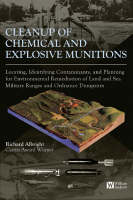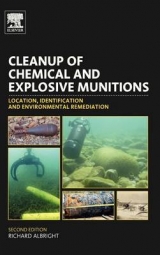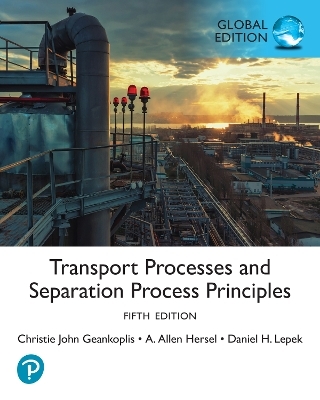
Cleanup of Chemical and Explosive Munitions
Locating, Identifying the contaminants, and Planning for Environmental Cleanup of Land and Sea Military Ranges and Dumpsites
Seiten
2008
William Andrew Publishing (Verlag)
978-0-8155-1540-1 (ISBN)
William Andrew Publishing (Verlag)
978-0-8155-1540-1 (ISBN)
- Titel erscheint in neuer Auflage
- Artikel merken
Zu diesem Artikel existiert eine Nachauflage
Offers instructions for cleaning up military ordnance sites, and lists of explosives, chemical warfare materials and breakdown products that the soil and groundwater must be tested for. This book includes archival studies; remote sensing techniques; geophysical techniques; safety issues; and a chemical weapons, and explosives and ordnance primer.
Unexploded military ordnance and toxic chemicals, some dating back to World War I, are a worldwide concern, especially at closed military bases that will be redeveloped for housing or civilian use. In Europe and Asia, many munitions sites are former battlegrounds; in Russia and its former territories, sites are used for storage and waste disposal. Experts estimate that the United States alone could spend between $50 and 250 billion dollars to cleanup these sites, many of which are in high-population density, residential areas. You might live near one such site right now. This book gives detailed instructions for cleaning up military ordnance sites, and lists of explosives, chemical warfare materials and breakdown products that the soil and groundwater must be tested for. Also included are archival studies; remote sensing techniques; geophysical techniques; safety issues; a chemical weapons, explosives and ordnance primer; known and unknown range lists; and a case study of documents written for cleaning up one of the worst examples yet: Spring Valley in the District of Columbia. It disproves myths, common misconceptions and lies, and explains what, how, and where to look for munitions and their residual contamination.
Unexploded military ordnance and toxic chemicals, some dating back to World War I, are a worldwide concern, especially at closed military bases that will be redeveloped for housing or civilian use. In Europe and Asia, many munitions sites are former battlegrounds; in Russia and its former territories, sites are used for storage and waste disposal. Experts estimate that the United States alone could spend between $50 and 250 billion dollars to cleanup these sites, many of which are in high-population density, residential areas. You might live near one such site right now. This book gives detailed instructions for cleaning up military ordnance sites, and lists of explosives, chemical warfare materials and breakdown products that the soil and groundwater must be tested for. Also included are archival studies; remote sensing techniques; geophysical techniques; safety issues; a chemical weapons, explosives and ordnance primer; known and unknown range lists; and a case study of documents written for cleaning up one of the worst examples yet: Spring Valley in the District of Columbia. It disproves myths, common misconceptions and lies, and explains what, how, and where to look for munitions and their residual contamination.
The Cleanup of Chemical and Explosive MunitionsCleaning Up Old Munitions Sites Limitations and Expertise in Remediating Munitions Sites Ordnance and Related Munitions Cleanup IssuesExplosive OrdnanceChemical Warfare MaterialA History of Ordnance Disposal PracticesOrdnance Detection TechnologyExcavation and Removal of OrdnanceRecommendations A History of the Spring Valley Site Concerns over the Adequacy of Previous Remediation Efforts The District of Columbia's Initial Success as a State Regulator on Spring Valley The Continuing Search for Burial SitesExpanding and Enlarging a Remediation Site The Dangers of Lewisite and Arsenic Sampling Conducted by the Army Corps of Engineers Conceptual Site Model for Spring Valley Summary
| Erscheint lt. Verlag | 4.7.2008 |
|---|---|
| Verlagsort | Norwich |
| Sprache | englisch |
| Maße | 152 x 229 mm |
| Gewicht | 650 g |
| Themenwelt | Technik ► Umwelttechnik / Biotechnologie |
| ISBN-10 | 0-8155-1540-5 / 0815515405 |
| ISBN-13 | 978-0-8155-1540-1 / 9780815515401 |
| Zustand | Neuware |
| Haben Sie eine Frage zum Produkt? |
Mehr entdecken
aus dem Bereich
aus dem Bereich
Kommentar der DIN 15905-5, LärmVibrationsArbSchV und …
Buch | Softcover (2023)
DIN Media (Verlag)
CHF 79,95
Buch | Softcover (2023)
DIN Media (Verlag)
CHF 105,55
Buch | Softcover (2024)
Pearson Education Limited (Verlag)
CHF 106,45



